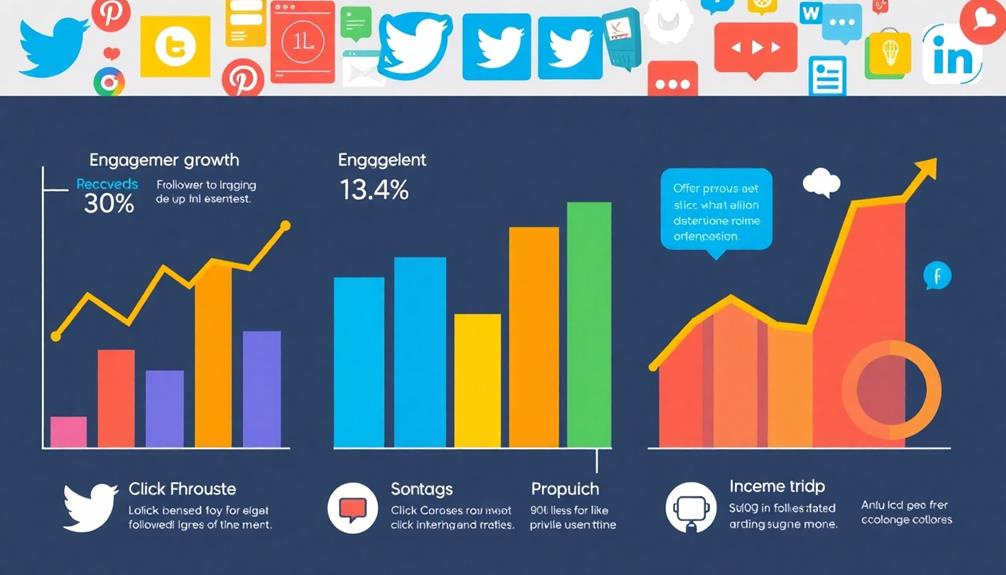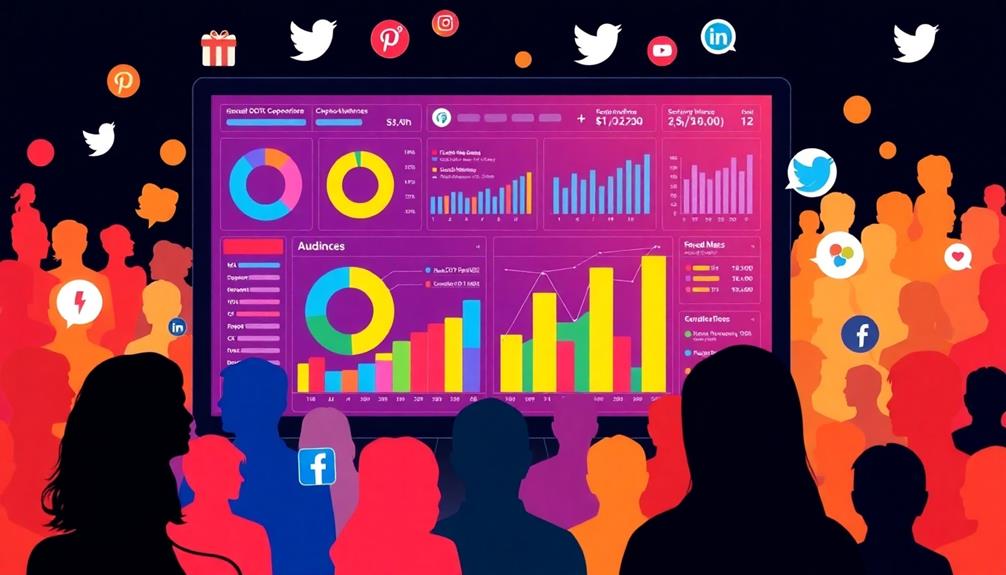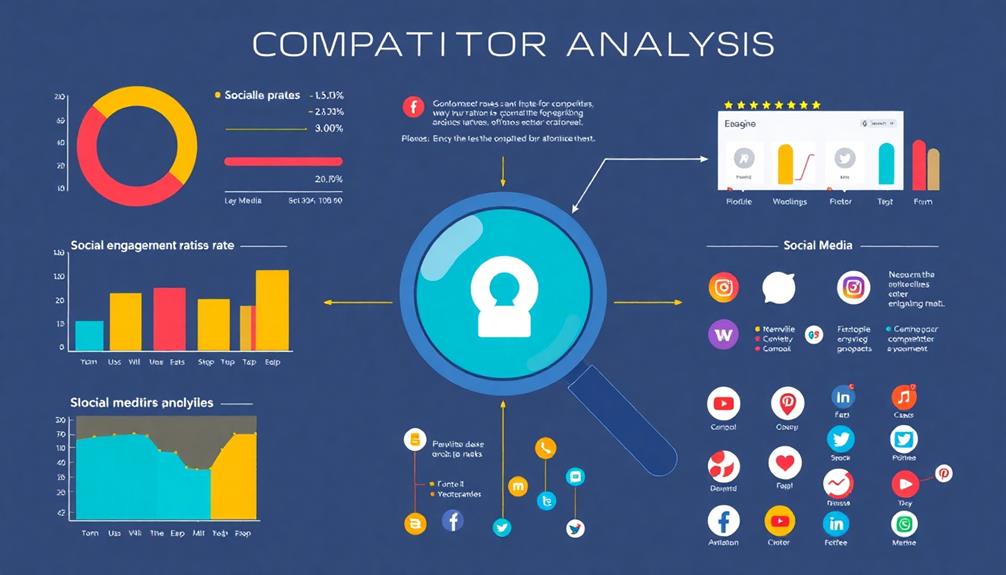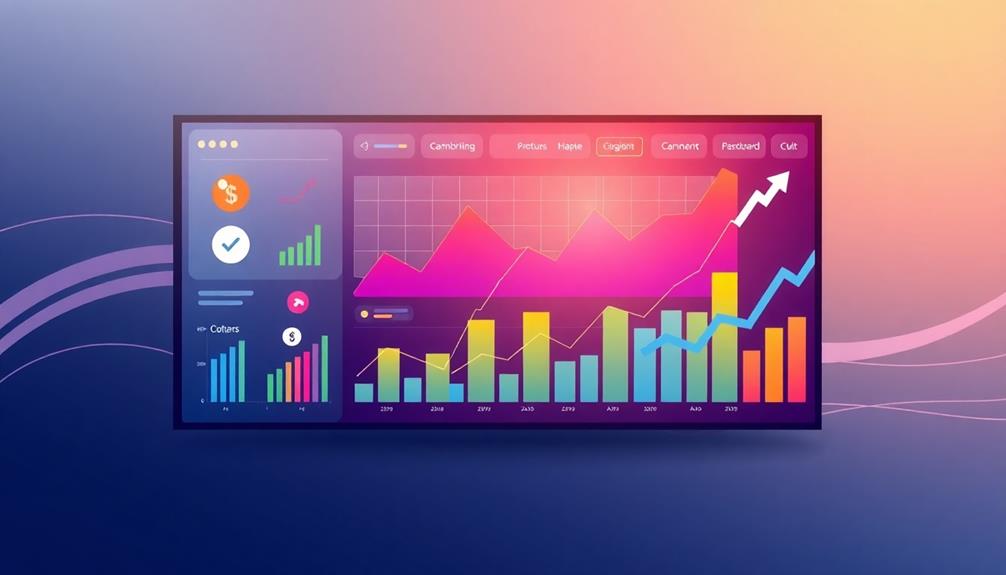Using analytics is essential for improving your social media strategy. You can track key metrics like engagement rates, reach, and conversion rates to gain insights into audience behavior. Tools such as Google Analytics and Sprout Social provide real-time data that helps you tailor your content for better engagement. By analyzing competitor strategies, you can identify gaps and refine your approach for maximum impact. Data-driven decisions increase your chances of meeting marketing goals considerably. With continuous testing and adjustment based on analytics, you'll see ongoing improvement in your social media presence. There's plenty more to explore to boost your strategy effectively.
Key Takeaways
- Utilize social media analytics tools like Sprout Social and Google Analytics to track engagement rates and audience demographics for tailored content strategies.
- Implement data-driven decisions to refine content, which can boost audience engagement by up to 20% and enhance ROI by 15%.
- Monitor key metrics such as conversion rates and audience growth rates to gauge the effectiveness of marketing strategies and optimize future campaigns.
- Conduct competitor analysis to identify performance gaps and adapt successful content strategies that resonate with your target audience.
- Continuously evaluate campaign effectiveness through engagement rates, reach, and unique promo codes to ensure ongoing optimization and improved results.
Understanding Social Media Analytics

Social media analytics is the key to revealing valuable insights about your audience. By collecting and analyzing data from various platforms, you can uncover how your audience interacts with your content, their preferences, and their behaviors. This understanding is essential for shaping effective marketing strategies.
Key metrics like engagement rates, reach, impressions, and conversion rates allow you to assess how well your content resonates with your audience. Additionally, understanding AI's role in cybersecurity can enhance your social media strategy by ensuring that your data is secure as you analyze it.
Using tools like Google Analytics and Sprout Social, you can track your social media performance in real-time. These insights help you identify trends and areas for improvement, ensuring your strategy remains effective.
A vital element of social media analytics is sentiment analysis, which enables you to gauge public perception and emotional responses to your brand. By examining user-generated content and interactions, you can better understand how your audience feels about your offerings.
With over 4.95 billion people using social media worldwide, this vast pool of data is an invaluable resource. Leveraging social media analytics not only enhances customer engagement but also drives informed business decisions that can lead to your brand's growth and success.
Importance of Data-Driven Decisions

Analyzing data from social media platforms not only uncovers audience insights but also highlights the significance of making data-driven decisions in your strategy. By leveraging social media analytics, you can tailor your content to perfectly align with your audience's preferences, leading to a remarkable 25% increase in customer satisfaction.
With the recent CrowdStrike outage affecting global operations, understanding your audience's needs through data becomes even more essential. When you implement these data-driven decisions, you're 60% more likely to achieve your marketing goals compared to those who don't utilize data insights.
Moreover, refining your content based on performance metrics can boost your audience engagement by up to 20%. This means that by understanding what resonates with your followers, you can create more engaging posts that keep them coming back for more.
Analytics-driven marketing strategies also enhance your return on investment (ROI) by 15%, as you allocate resources more efficiently based on proven interactions.
Real-time data analysis empowers you to adapt your strategies quickly, improving campaign performance by an average of 30%. By responding to emerging trends and audience sentiments, you guarantee that your social media efforts remain relevant and effective, ultimately driving your business success.
Key Metrics to Track

When it comes to optimizing your social media strategy, tracking the right metrics is essential. Start with the engagement rate, which measures how much your audience interacts with your content through likes, comments, and shares. A higher engagement rate means your content resonates well, building a stronger connection with your followers.
Additionally, leveraging data-driven marketing strategies can help you identify trends and tailor your content to better meet your audience's preferences.
Next, keep an eye on the audience growth rate. This metric indicates how quickly your following is expanding, calculated by the net new followers divided by your total followers at the beginning of the period. Understanding this rate helps you gauge the effectiveness of your growth strategies.
Don't forget about the conversion rate, too. This metric shows the percentage of users who complete a desired action, like making a purchase, after engaging with your content. Monitoring the conversion rate allows you to assess the success of your campaigns in driving sales and achieving your marketing goals.
Tools for Effective Analytics

To effectively measure and enhance your social media performance, leveraging the right analytics tools is essential. Social media analytics tools like Sprout Social provide in-depth insights, allowing you to track engagement metrics such as likes, shares, and comments across multiple platforms.
This information is vital for making data-driven strategy adjustments, much like how diversification strategy helps mitigate risk in investing.
Google Analytics is another powerful tool, helping you monitor website traffic originating from your social media channels. It offers insights into user behavior and conversion rates, which are important for evaluating your campaign's effectiveness.
Hootsuite aggregates performance data from various networks, giving you a centralized view that helps identify trends and optimize content strategies based on audience engagement.
If you prefer a user-friendly interface, Buffer allows you to analyze post performance metrics easily, refining your content and posting schedules to maximize reach and engagement.
Tools like Later and Rival IQ offer specialized features such as content previews and competitive analysis, ensuring thorough tracking and reporting.
Audience Insights and Segmentation

Understanding your audience is essential for crafting effective social media strategies. By diving into audience insights, you can tailor your content based on specific characteristics that resonate with your followers.
Emphasize gratitude to enhance professional growth and engagement. Here are four key aspects to reflect on:
- Audience Demographics: Analyze data such as age, gender, and location to understand who your audience is. This helps in creating content that appeals directly to them.
- Interests and Behaviors: Segment your audience based on their interests and online behavior. This allows you to develop personalized marketing strategies that speak directly to each group's unique preferences.
- Tools for Insights: Utilize platforms like Sprout Social to gather industry-specific information. These tools help refine your content strategies, ensuring they align with audience preferences.
- Continuous Monitoring: Keep an eye on engagement patterns to identify which content types drive the most interaction. This ongoing optimization can enhance your social media efforts considerably.
Competitor Analysis Techniques

Competitor analysis techniques are essential for refining your social media strategy and gaining a competitive edge. By evaluating your competitors' follower counts and engagement rates, you can identify performance gaps and set realistic benchmarks for your growth. Tools like Sprout Social can help you consolidate this data across various networks, enabling you to compare your performance metrics against industry standards effectively.
Additionally, leveraging data analytics for targeted advertising can further enhance your understanding of successful strategies in your niche.
Take a close look at your competitors' content strategies, including their post frequency and the types of content they share. This examination can reveal what resonates with your target audience, allowing you to inform your own content creation efforts.
Additionally, monitoring audience demographics and engagement patterns will help you understand your competitors' strengths and weaknesses, letting you tailor your strategies to target untapped market segments.
Don't overlook the insights gained from evaluating your competitors' paid social campaigns. By analyzing their ad formats and engagement metrics, you can gather valuable information on successful tactics that you can adapt to optimize your advertising strategies for better ROI.
Embrace these competitor analysis techniques, and watch your social media strategy evolve and improve.
Paid Social Performance Metrics

Measuring the effectiveness of your paid social campaigns is essential for optimizing your advertising efforts. Understanding paid social performance metrics helps you pinpoint what's working and what needs improvement.
For instance, analyzing your RMD strategies could provide insights into timing and distribution that parallel your social media efforts. Here are four key metrics to focus on:
- Click-Through Rates (CTR): This metric shows the percentage of users who clicked your ad after seeing it. An average CTR across platforms usually hovers around 2-3%.
- Cost-Per-Click (CPC): Knowing your average CPC, which for Facebook ads is about $1.72, helps you understand how much you're paying for each click on your ad.
- Conversion Rates: This determines the percentage of users who complete a desired action after clicking. A benchmark for e-commerce is around 2-5%, making it essential for evaluating campaign effectiveness.
- Engagement Metrics: Likes, shares, and comments on your ads provide insight into audience interaction. High engagement can greatly boost your campaign's reach and success.
Influencer Campaign Analytics

When you're running influencer campaigns, measuring engagement metrics is essential to understanding their impact.
Utilizing AI privacy protection can also enhance your data collection methods while ensuring user trust.
You'll want to evaluate influencer performance by tracking key indicators like reach and conversion rates.
Measuring Engagement Metrics
Engagement metrics are vital for evaluating the success of influencer campaigns. By focusing on these metrics, you can gain valuable insights into how well your content resonates with your audience.
Additionally, understanding strategies for building a loyal podcast audience can enhance your influencer marketing efforts. Here are four key engagement metrics to measure:
- Likes: Reflects immediate approval and interest in the content.
- Comments: Indicates deeper engagement and provides feedback directly from your audience.
- Shares: Shows how likely your content is to be spread within networks, enhancing brand visibility.
- Saves: Demonstrates that users find the content valuable enough to revisit later.
When analyzing audience demographics, you can tailor your campaigns to influencers who best connect with your target market. This step is essential for measuring ROI, as it allows you to track direct conversions through unique promo codes or affiliate links associated with influencers.
Additionally, monitoring hashtag usage can reveal patterns in audience interactions, helping you optimize future strategies. By focusing on these engagement metrics, you can refine your influencer marketing approach and drive better results for your brand.
Evaluating Influencer Performance
To effectively evaluate influencer performance, brands must analyze key metrics that reveal the impact of their campaigns. Start by tracking engagement rates, which include likes, comments, and shares per post. This data gives you insights into how well the audience responds to the influencer's messaging. High engagement rates often indicate that the content resonates with followers, enhancing your brand's visibility.
Additionally, exploring top platforms for influencer collaborations can provide a broader perspective on effective strategies within the industry.
Next, assess audience reach. Monitoring how many people see the influencer's posts helps you understand the potential exposure of your campaigns. Combining reach with engagement rates provides a clearer picture of overall effectiveness.
Don't forget to measure conversions generated from influencer campaigns. By using unique promo codes or affiliate links, you can accurately calculate the ROI from each influencer. This direct attribution of sales can greatly inform your future marketing strategies.
Lastly, compare the influencer's metrics against industry benchmarks. This comparison allows you to identify high-performing influencers and make data-driven decisions for optimizing future collaborations.
Tracking Campaign Effectiveness
As brands aim to maximize their marketing impact, tracking campaign effectiveness through influencer analytics becomes essential.
To effectively measure the success of your influencer partnerships, focus on these key metrics:
- Engagement Rates: Monitor likes, comments, and shares to understand how well your audience is interacting with the content.
- Reach: Analyze how many people see your influencer's posts, offering insight into brand visibility.
- Conversion Rates: Utilize unique promo codes to track sales directly attributed to each influencer, allowing for a clear ROI assessment.
- Hashtag Effectiveness: Review the performance of hashtags used during the campaign to gauge audience engagement levels and refine future strategies.
Testing and Iteration Strategies

Testing and iteration strategies are essential for optimizing social media performance. Start by implementing A/B testing, where you experiment with different content types, posting times, and audience segments. This approach helps you identify which combinations yield the highest engagement rates.
Utilize analytics tools to track and compare performance metrics from various test campaigns. This data-driven decision-making allows you to adjust your content strategy effectively.
Regularly analyze audience feedback and engagement data to refine your messaging. By understanding what resonates with your audience, you can optimize your content to better meet their preferences.
Foster a culture of experimentation within your team by encouraging members to propose and test new ideas based on analytical insights and emerging trends.
After each campaign, continuously iterate on your strategies by reviewing performance data. Ascertain that the lessons learned are applied to future social media efforts, which leads to ongoing improvement.
By embracing testing and iteration, you'll not only enhance your social media performance but also create a more engaging experience for your audience.
Real-World Case Studies

Now, let's look at how companies like Netflix, Coca-Cola, and Nike use social media analytics to boost their success.
You'll see how Netflix taps into viewer behavior for content recommendations.
Coca-Cola measures sentiment to shape its marketing.
Nike targets campaigns effectively to increase sales.
These real-world examples show the power of analytics in driving engagement and growth.
Netflix's Viewer Behavior Insights
Many viewers mightn't realize how deeply Netflix analyzes their watching habits to enhance the viewing experience. By leveraging viewer behavior insights, Netflix greatly personalizes recommendations, leading to improved user engagement and high retention rates.
Here are four key strategies they employ:
- Watch Patterns: Netflix tracks completion rates and viewing times to identify which genres and titles resonate with different demographics. This data guides their content acquisition and original programming decisions.
- A/B Testing: They conduct A/B tests on thumbnails and descriptions to maximize click-through rates. By tailoring visuals based on historical engagement data, Netflix captures attention effectively.
- Sentiment Analysis: Utilizing sentiment analysis from social media platforms, Netflix gauges audience reactions to new releases. This allows them to adjust marketing strategies and enhance viewer satisfaction.
- Interactive Content: Their analytics reveal that users engaging with interactive content, like "Bandersnatch," are more likely to return. This emphasizes the importance of innovative content formats in driving future engagement.
Through these methods, Netflix continuously refines its approach, ensuring that viewer behavior insights translate into a compelling and satisfying viewing experience.
Coca-Cola's Sentiment Analysis Strategy
Coca-Cola effectively harnesses sentiment analysis to gauge public reactions to its marketing efforts, guaranteeing that its messaging resonates with consumers. By analyzing social media conversations, you can see how Coca-Cola identifies emerging trends and consumer preferences. This allows the company to pivot its marketing strategies quickly, maintaining relevance in a fast-changing landscape.
Coca-Cola employs sentiment analysis tools to evaluate customer feedback on new product launches. This guarantees that their offerings align with consumer expectations and desires, leading to a more satisfied audience. By tapping into these customer insights, Coca-Cola creates personalized marketing content that speaks directly to their audience's sentiments.
Moreover, sentiment analysis plays a vital role in Coca-Cola's crisis management strategies. When negative perceptions arise, the company can address issues swiftly and effectively, protecting its brand reputation. This proactive approach not only mitigates potential damage but also fosters increased customer satisfaction and engagement.
Nike's Targeted Campaign Success
Nike's innovative approach to social media analytics has propelled its campaigns into the spotlight, demonstrating the power of targeted marketing. By analyzing customer engagement and preferences, Nike crafts tailored campaigns that resonate with specific audience segments.
Here are some key successes:
- "Dream Crazy" Campaign: Featuring Colin Kaepernick, this campaign led to a 20% increase in online sales shortly after launch.
- Diverse Demographics: Insights from audience analytics boosted Nike's follower engagement rate by 48% on Instagram, allowing them to connect with a wider audience.
- Positive Brand Sentiment: Through sentiment analysis, Nike adjusted strategies during the "You Can't Stop Us" campaign, resulting in a 10% increase in brand sentiment.
- Influencer Partnerships: By tracking influencer performance, Nike partnered with key figures, enhancing campaign reach and engagement by 27%.
Nike's commitment to using social media analytics not only drives engagement and conversion but also strengthens brand sentiment.
Their data-driven strategies, like A/B testing, lead to significant improvements, showcasing how analytics can transform your social media approach effectively.
Frequently Asked Questions
How Would You Use Social Media Analytics to Improve Your Social Media Strategy?
To improve your social media strategy, set SMART goals, identify key metrics, and leverage analytics tools. Analyze audience engagement and conduct competitor analysis to refine your content and enhance your overall performance effectively.
How Can Social Media Analytics Be Used in Content Strategy?
In today's digital jungle, you can harness social media analytics to pinpoint engaging content types, tailor messaging to your audience's preferences, and track performance metrics for ideal posting times, enhancing your overall content strategy.
How Are Analytics Used in Social Media?
Analytics in social media help you track user interactions, measure engagement, and assess content performance. By analyzing data, you can identify trends, understand your audience better, and refine your strategies for improved results.
How Can Social Media Analytics Benefit a Marketing Strategy?
You'll find social media analytics transforms your marketing strategy. It uncovers audience preferences, sharpens your messaging, and enhances engagement. By tracking performance, you can make informed decisions that boost your brand's visibility and drive growth.
Conclusion
Incorporating analytics into your social media strategy is like having a compass on a journey—it guides you toward success. By understanding key metrics and leveraging the right tools, you can make data-driven decisions that resonate with your audience. Don't shy away from testing and iterating; it's all part of refining your approach. With the insights you gain, you'll not only enhance engagement but also build a more effective and impactful social media presence.










